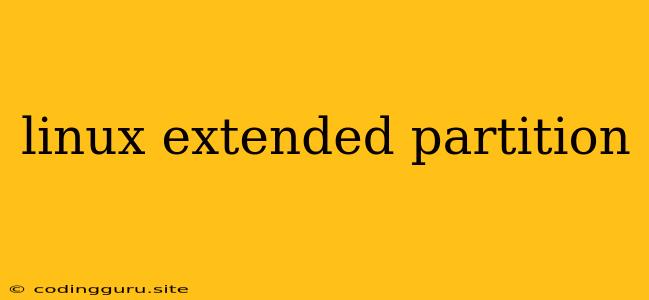Demystifying Linux Extended Partitions: Your Guide to Mastering Disk Space
Linux, renowned for its flexibility and power, often demands a keen understanding of disk partitioning. One of the key concepts you'll encounter is the extended partition, a vital element in managing your storage space efficiently. But what exactly are they, and why are they so important? Let's dive into the world of extended partitions and unravel their mysteries.
Understanding the Basics of Partitions
Before diving into the complexities of extended partitions, it's essential to understand the basic concepts of partitioning. Imagine your hard drive as a vast, unorganized canvas. Partitioning is the act of dividing this canvas into smaller, distinct areas, each with its own purpose. These areas are known as partitions.
Each partition acts like a separate disk, allowing you to install different operating systems or allocate space for different purposes, such as storing your personal files, installing software, or running specific programs.
The Role of Extended Partitions: Breaking Down the Limits
So, why do we need extended partitions? The answer lies in the limitations of traditional primary partitions. Linux, by default, allows you to create a maximum of four primary partitions on a single disk. This might seem sufficient for many users, but what happens when you need more than four partitions? Enter the extended partition.
An extended partition acts as a container, allowing you to create an unlimited number of logical partitions within it. These logical partitions essentially function as additional primary partitions, extending your partitioning capacity beyond the four-partition limit.
Creating an Extended Partition: A Practical Guide
Here's how to create an extended partition using the fdisk command line tool, a common method for managing partitions on Linux systems:
- Access the
fdisktool: Open your terminal and typesudo fdisk /dev/sdX, where/dev/sdXrepresents the device name of your hard drive (replaceXwith the appropriate letter, e.g.,sda). - Create a new partition: Type
nto create a new partition. - Choose a partition type: Enter
pfor primary partition andefor extended partition. Selectefor this example. - Specify partition number: Choose a free partition number for your extended partition.
- Define the partition size: Set the starting and ending sectors of your extended partition based on your available disk space.
- Write changes: After defining your partition parameters, type
wto save changes and exitfdisk.
Formatting and Mounting the Extended Partition
Once you've created the extended partition, you'll need to format it with a suitable file system, such as ext4 or XFS, using the mkfs command. Finally, mount the extended partition to a directory in your file system to access its contents. This process involves creating a mount point, and specifying the partition and mount point in your /etc/fstab file.
Understanding the Benefits of Extended Partitions
Extended partitions offer significant benefits for Linux users:
- Enhanced Flexibility: The ability to create unlimited logical partitions within an extended partition provides greater flexibility in organizing and managing your disk space.
- Dedicated Storage: You can dedicate specific logical partitions for different purposes, such as system files, user data, or specific applications.
- Efficient Resource Allocation: By segmenting your storage space into distinct partitions, you can optimize resource allocation and maintain a more organized system.
Important Considerations:
- The
mbrandgptPartitioning Schemes: The method of creating and managing partitions is influenced by the partitioning scheme used. While extended partitions are commonly associated with the oldermbrscheme, the newergptscheme offers enhanced features, including the ability to create multiple primary partitions without the limitation of thembrscheme. - System Compatibility: Be aware that not all operating systems, including older versions of Windows, may fully support the extended partition concept.
Troubleshooting Common Issues
Here are some common issues you might encounter when working with extended partitions:
- Partition Table Errors: Errors in your partition table can prevent your system from accessing the extended partition properly. You can use tools like
fdiskorgdiskto repair these errors. - Mount Point Conflicts: Conflicting mount points can lead to problems accessing your extended partition. Ensure that each partition is mounted to a unique directory.
- File System Corruption: If your extended partition becomes corrupt, you may need to repair or reformat it. Tools like
fsckcan assist in repairing file system errors.
Conclusion
Extended partitions play a crucial role in managing your disk space efficiently on Linux systems. By understanding their purpose, structure, and practical implementation, you can effectively leverage their capabilities to optimize your storage configuration, enabling a more organized and efficient system.
As you continue your journey with Linux, remember that extended partitions are not simply an advanced concept; they're a fundamental tool for achieving a smooth and reliable system. With a grasp of extended partitions, you'll unlock greater flexibility and control over your storage space, paving the way for a more efficient and optimized Linux experience.
